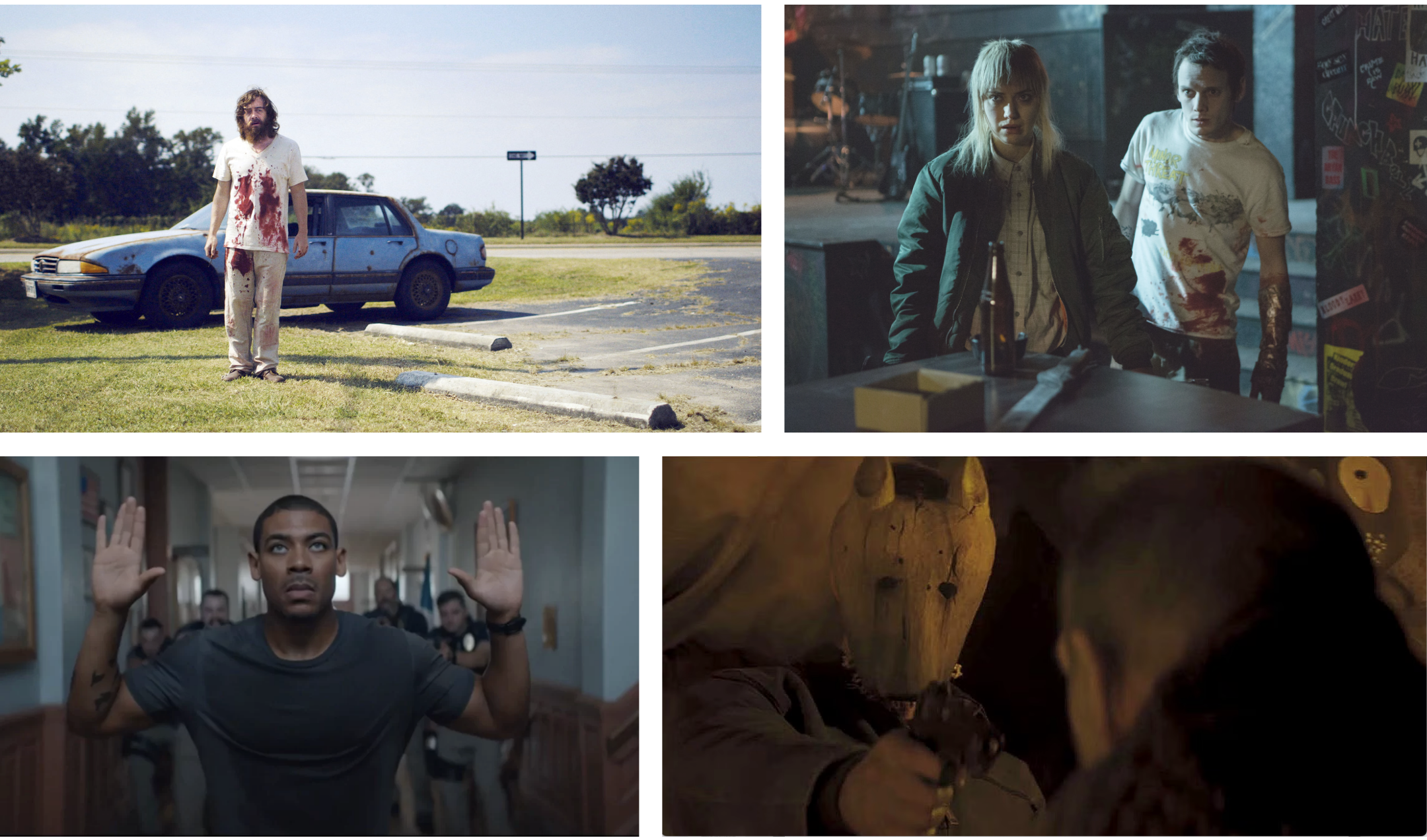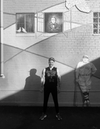Jeremy Saulnier’s American Carnage
Corey Atad on Blue Ruin, Green Room, Rebel Ridge and American violence

by Corey Atad
A man has just been shot in the head. From a good distance by some kind of sniper rifle. A stunned Dwight Evans (Macon Blair) struggles to collect himself. Despite having already killed a man with a knife in bloody, intimate fashion, Dwight can’t quite comprehend the nature of what he’s just witnessed, though it spared him his life. “That’s his head,” he says in his state of shock, to which his saviour, the sniper, responds in a casual but grave tone, “That’s what bullets do.” Collecting the body, Dwight continues in a daze. What to do with the other parts of the man’s head? The violence he’s unleashed has upended any theoretical notions of vengeance that have lived in his mind and his heart for decades. What he’s left with is brain matter and bits of skull strewn across the grass, as though seeding the landscape, and a dawning realization that the sowing is far from over.
2013’s Blue Ruin was writer-director Jeremy Saulnier’s breakout feature, though not his first. He and Blair had come up together, making movies as kids, and eventually getting their shit together enough to make the 2007 horror comedy Murder Party. Shot on the pretty crappy digital video of the era, the film is about a guy kidnapped by a group of art school freaks on Halloween, who are making a project out of torturing and killing someone for the sake of a grant application. Its satire is broad, its commentary facile, and it eventually wears out its running time, but its violence is at first genuinely startling before taking a turn for the gorily goofy.
Violence has been Saulnier’s great subject from the start, and he takes particular interest in its resulting carnage. Unlike other gorehounds, there’s no stylistic pleasure to be found in the way he splashes viscera onscreen. Even in Murder Party—which descends into cartoony levels of “how is this person not dead yet?”—the bloody mess is difficult to take.
When Blue Ruin first landed—years after Saulnier’s initial no-budget debut, and a string of jobs as a cinematographer, including on Matthew Porterfield’s great, under-seen, Maryland-set indie films—its biggest point of comparison was the Coen brothers. Blood Simple, Fargo, and No Country for Old Men loomed large over his very American tale of violent deeds getting wildly out of hand. At the time I remember feeling a shallowness in the comparison, which I took to mean Blue Ruin was a shallow imitation. It took his 2024 film Rebel Ridge – a recent winner of best TV movie at the 2025 Creative Arts Emmy Awards – and finally getting around to 2015’s Green Room to force a rethink of Saulnier as something more than a sure-handed genre guy.
Finally rewatching Blue Ruin, though still not a pox on the Coens for pure talent and intellectual heft, it struck me that his aims are entirely distinct. While the Coens take deep interest in the workings of America as a violent, miserable tapestry, their frame is a stylized one, filtered through old noirs and pulp novels. What’s disturbing in their work is not the reality of the violence, but its blunt uncanniness, an expression of irony. Blue Ruin is absent of irony. In fact, its ending negates any of the detachment expected in its plotting, taking a story of vengeance turning back on the vengeful, and finding peace in the knowledge of its inescapability.
What Saulnier sees in his vision of America—settings ranging from Delaware, to the Pacific Northwest, to Alaska, and down to small-town Louisiana—is the perpetual carnage baked into the country’s spirit. The idea of America as uniquely violent is a fiction those who’ve never been anywhere else like to tell themselves, but Saulnier sees a different truth about his country. It’s not the violence, but the blood on the soil, as it were. A land of violent conquest, its spirit irrevocably marred by the seepage from battered bodies, where dreams of civilization, democracy, and liberalism bump against the bloodshed that birthed those ideas. Saulnier’s America is an endless Wild West, the bloody mess at the edges of society, where rules of order break down and systemic failures reveal the limits of the social contract.
Saulnier’s great masterpiece is Green Room, a film I only saw this year for the first time, for $5 at a tiny theatre in Toronto. For much of its 95 minutes, I sat utterly gripped and horrified. The story of a punk band who take a shitty gig at a Neo-Nazi bar, accidentally witness a murder, and then attempt to fight their way out, the film is elevated by the sheer unpleasantness of its violence. Arms chopped by knives, throats ripped out by dogs, buckshot to the head, shivs in the back, bellies sliced open by boxcutters. The procession of terror visited upon the characters in the film spills from the screen like an embodiment of the ideological ugliness staining the beautiful greenery of Oregon. Complaints from some critics that the film’s depiction of Neo-Nazis was soft, failing to make a real point of their racism, belie its real insight: these guys, at the end of the earth, believe doling out violence is their birthright. Hatred is an animating idea, but it’s the act of maiming and killing that gives substance to their sick vision of the world, which is far more self-serving than principled.
In Rebel Ridge, which took years of aborted attempts to get off the ground, Saulnier flips everything, centering the story on a man trained in martial arts to disarm and deescalate. Biking into town with a giant wad of cash to post bail for his cousin, who is about to be sent to a jail where guys who want to kill him are waiting, Terry Richmond (Aaron Pierre) is run off the road by a cop, who proceeds to steal his money via dubious civil forfeiture laws. All Terry wants is his money back and to protect his cousin. None of this goes well. What he uncovers is a small-town conspiracy of cops and local officials using underhanded tactics like civil forfeiture to raise funds, while keeping their community in line, silent. Necessary measures taken to enforce compliance. This is the violence of systems; the carnage comes in the collateral damage. Terry does all he can to engage in violence with a respect for human life and people’s bodily integrity, but the bloody mess surrounds him anyway. His victory is pyrrhic, satisfying only in the comeuppance received by some asshole police. It prevented nothing, and may amount to less in the end.
This view of American life, unalterably tainted by its violent soul, is perhaps most at work in the film Saulnier didn’t write. Hold the Dark stars Jeffrey Wright as a man enlisted to hunt down a pack of wolves believed to be responsible for the disappearances of three local children in a small Alaska village. What he uncovers is a depth of violence at the heart of the American experience that verges on the mythical. Too sprawling, and too dour in its tone, Hold the Dark is Saulnier’s least effective directorial effort, but an oddly perfect expression of his notion of a country revealing its true nature at the margins of civilization, where the sick spirit of colonialism reaches its ends. Out here, in the cold wilderness, far up north, the cruelty of humanity feels at one with the environment. It’s the blood seeping into the ground of Blue Ruin, visited back upon a community by a kind of natural force. Except that there is no real distinction between the two. When we’re introduced to the father of the story’s central missing boy, played by Alexander Skarsgård, he is a soldier in Iraq, coming across one of his fellow fighters raping a woman. He summarily executes the man with a knife to the armpit; a gruesome scene that engenders only horror at a theoretically justified act. When he returns to Alaska, he continues his killing spree, his psychopathy becoming more and more evident, a perfect distillation of the rageful spirit haunting the landscape. Reunited with his wife, they are last seen pulling their son’s coffin behind them, trudging through the snow into a vast nothingness. There is no righteousness to be found here, only carnage.
Corey Atad is a writer in Toronto. He previously wrote for Hell World about the life and work of David Lynch, the films Se7en; The Zone of Interest; Megalopolis; and the series The Bear.
